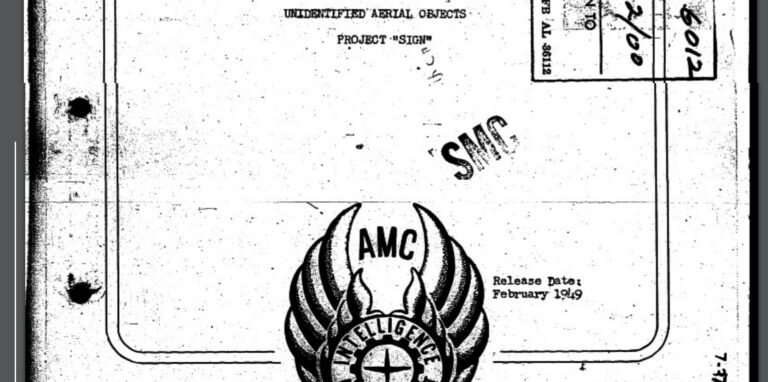Most of us are familiar with the attitude of the U.S. Air Force toward potential UFO sightings and the subject of potential alien visitors starting with the close of Project Blue Book in 1969. ‘Nothing to see here. Move along.’ But in the earliest days of their investigations into this phenomenon, their approach was significantly different. When the Air Force was in the midst of Project Sign (the predecessor of Project Grudge), they were keenly interested in not only studying the reported objects in the skies but also who might be piloting them. And they did not take the possibility of visitors from another world off the table.
As part of Project Sign, Brigadier General Donald Leander Putt, director of Research and Development for Materiel at Air Force headquarters, Washington, D.C., sent a letter on November 18, 1948, to Franklin R. “Frank” Collbohm, founder of the RAND Corporation. He spoke of “the flying object problem” and requested a scientific study on the possibilities as to not only what the objects might be, but the feasibility of aliens from another planet in our solar system or even another star system being responsible. Collbohm agreed to the request and assigned the task to James E. Lipp, a scientist who would go on to produce many technical reports for the United States government in the field of space travel, including “Utility of a Satellite Vehicle for Reconnaissance” in the early 1950s.
Lipp completed his nine-page report and submitted it to the Air Force on December 13, 1948. It was included in the full Project Sign report. The most legible copy of the full report can be viewed at the NICAP website. The Debrief reviewed the full RAND Corporation report and found a number of interesting observations about prevailing theories about potential extraterrestrial lifeforms and the technologies they might possess. There is no reason to mock some of the assumptions and conclusions in the report as they reflect the current state of knowledge of the solar system in the forties. But the results are certainly instructive as to the approach the Air Force was taking regarding this topic at the time.
MARTIANS, VENUSIANS, AND SPACEMEN, OH MY!
Lipp’s report includes multiple references to the current work of scientists and even science fiction writers of the time who had been considering the possibilities of intelligent life on planets other than earth and the technologies that would be required to engage in space travel. On the subject of possible intelligent, non-human civilizations elsewhere in our solar system, Lipp states that “astronomers are largely in agreement that only one member of the solar system (besides Earth) can support higher forms of life. It is the planet Mars.”


He goes on to quote the 1941 book “Earth, Moon and Planets” by Fred Lawrence Whipple. The passage from the book concludes that advanced life likely did arise on Mars, but the Martians either moved underground as the surface conditions deteriorated, evolved to survive in the harsher conditions, or simply perished. The passage concludes by stating that the existence of intelligent life on Mars is “not impossible, but it is completely unproven.”
Lipp also briefly speculates on the possibility of intelligent life on Venus, saying that it would be “strange to us” because of the wildly different conditions on the surface. But he then suggests that the cloudy atmosphere of Venus “would discourage astronomy, hence space travel.”
The report then speculates that if a technologically advanced race of Martians were visiting the Earth, they would have already established direct communications with mankind. “It is hard to believe that any technically accomplished race would come here, flaunt its ability in mysterious ways and then simply go away.” This is only one of many similarities seen between Lipp’s analysis in 1948 and the debates currently taking place among those investigating the UAP phenomenon.
THE MOTIVES AND ORIGINS OF THE ALIENS WERE HOTLY DEBATED
If technologically advanced Martians were actually coming to Earth, Lipp offers a fascinating reason as to their motivation. He notes the recent development of atomic weapons by humans, leading the potential Martians to see the mushroom clouds erupting from our planet as “evidence that we are warlike and on the threshold of space travel.” This is quite similar to current speculation regarding sightings of UAP near American nuclear weapons facilities over the years, suggesting that they may be interested in disarming us. Yet he concludes that the technological challenges of travel between the planets are so great that “the odds are at least a thousand-to-one against it.”
Lipp also explores the possibility that the aliens might be coming from a different star system. For some reason, he limits the search for their homeworld to a distance of 16 light-years from Earth. He eliminates all binary and trinary systems as lacking the conditions required for stable planetary orbits, something we now know to be incorrect. He also eliminates white dwarf stars (along with red giants) as being the wrong size to host habitable planets. This has also proven to be untrue.
Of the remaining 22 “suitable” stars in our vicinity, Lipp offers what he admits is “personal intuition” and concludes that each star likely has either one or two habitable planets and nearly all of them should host some form of life. Of those, he predicts that eleven of them should be home to intelligent civilizations that are more advanced than humans and already engaging in space travel. But he next breaks down a very scientific-looking analysis of the mechanical designs and fuel requirements for spaceships that would ferry passengers between the stars, concluding that the amount of energy needed to achieve the speeds required “is completely beyond the reach of any predicted level of rocket propulsion.” And even if a “super-race” capable of the feat is out there, they would be unlikely to stumble upon our sun, “a fifth-magnitude star in the rarefied outskirts of the galaxy.”
THE AIR FORCE DIDN’T SEE THE UFO ISSUE AS A GLOBAL PROBLEM
Also of interest is Lipp’s assertion that, as far as he knows, all incidents of sightings of unidentified flying objects “have occurred in the United States.” But if there are “visiting spacemen” showing up they should be expected to visit all the nations of our world. Of course, we now understand that UFOs are sighted all around the world, but Lipp’s team was clearly thinking of the problem in American-centric terms.
Lipp further questioned “the lack of purpose” of the spacecraft, suggesting that the only obvious motive the spacemen might have is to “feel out our defenses without wanting to be belligerent.” This also bears a striking resemblance to the current UAP debate in Washington which tends to focus on the national security aspect of the situation and the potential threat these craft might present.
Lipp’s final conclusion is that while visits from outer space are believed to be possible, “they are believed to be very improbable” and the actions attributed to the flying saucers were “inconsistent with the requirements for space travel.”
CONCLUSIONS
The longstanding silence of the United States Air Force when it comes to the subject of UAP, as recently eloquently characterized at The Debrief by Christopher Mellon, represents a challenge to those seeking more governmental transparency when it comes to investigations into this matter. This is a subject that some elected representatives such as Kirsten Gillibrand continue to hammer home in a variety of investigative activities.
But in the early days of the United States’ military investigations into the subject, that obviously wasn’t the case. The Air Force was examining a seemingly intractable problem that may or may not have represented a valid concern in terms of the security of not only America but the entire world. What changed after the close of Operation Blue Book? The governmental records that have been revealed thus far offer clues, but little of substance to suggest who the primary actors were or how they reached their conclusions.
As this analysis suggests, however, the questions being posed today are eerily reminiscent of the debates that were taking place inside of the American military more than seventy years ago. A very famous person once proclaimed that those who cannot remember the past are condemned to repeat it. Hopefully, that’s not what we are witnessing today.

